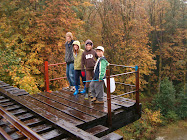

 On a wonderful nature walk with another homeschooling family, we came across this spectacular pileated woodpecker. He was so engrossed in his "pecking search" for some juicy grubs, that he didn't pay any mind to the 10 person audience that he had before him. We observed him eat and peck; peck and eat, for about 10 -15 minutes. What a show!
On a wonderful nature walk with another homeschooling family, we came across this spectacular pileated woodpecker. He was so engrossed in his "pecking search" for some juicy grubs, that he didn't pay any mind to the 10 person audience that he had before him. We observed him eat and peck; peck and eat, for about 10 -15 minutes. What a show!I've noticed woodpecker-like birds in our backyard before and I think they're some type of flicker, maybe golden. They like to peck the ground with great speed and they move around quite quickly. I've also heard woodpeckers, in years past, pecking on my roof! It's sounds like a jackhammer. Once there was a woodpecker pecking on the metal smokestack on our roof, which caused quite the vibration. I hear they like to make these kinds of loud noises, like pecking a roof or something metal, when calling for a mate.
I tried to look up the different species of woodpeckers in our bird book so that I could recall this one's name (pileated)and name of the flicker species(golden) that we see in our backyard, but those pages were missing out of the book. The field guide of Western Birds book was given to my son, Mitchel, (the animal lover from ages 2 - 12) at the age of 6, I think. He read this book so often that the pages fell out and I must of thrown them out during a de-clutter mode (of which I get in too often and end up getting rid of stuff and later regretting it - like some much missed lapbooks!).
Mitch had us reading to him from the Animal Atlas (this might be the one)at age 2. When anyone who came to visit and wanted to read to him, this was his book of choice for a good couple of years. By reading this book to him, he knew his continents quite well by the age of 5. Then he was given The Children's Animal Encyclopedia which had its binding falling apart, then the whole book came apart, after 3 years. I replaced that book, after coming across it in a discount pile of books in a store and because he loved it so much, I just couldn't walk away without it. Then he was given the Smithsonian Institution Animal book which is still okay, but the binding is hanging on for dear life. We have many wonderful animal books all due to my animal/nature loving kids; Mitch started the trend.
I keep the bird guide book in my "nature basket" which houses many field guides: birds, plants, reptiles, bugs, seashore, and animal tracks. The Lone Pine books are very good guides. I also keep magnifying glasses, binoculars, spiral bound sketch books, a pencil box, Anna Bomstock's Handbook of Nature Study and a lovely book called Keeping a Nature Journal. The best sketch books that I have found( in terms of quality, ease and cost) to use as nature journals are at Coombs Country Market. I prefer spiral bound books because the pages are easy to flip and they won't tear out easily. The size of these sketch books makes it easy to slip it into a zip lock bag and throw into a backpack. The quality of paper in these books is equal to that of sketch pads with medium to heavy paper. In our pencil box we keep pencils of varying shades/numbers, a kneaded eraser and a stump for shading and blending. I also have watercolour pencils, but we haven't used them yet. We haven't journaled a lot, but should we feel moved to do it, we have all we need to have a great experience.
A wonderful nature journal book to gaze over is The Country Diary of an Edwardian Lady by Edith Holden. It's a sweet, captivating and simple book which contains her nature notes on the flora on fauna of the British countryside during the year of 1906. It's a book that fits in perfectly with a cup of tea on a rainy day.
All these thoughts are making me think that we need to get back into nature journaling. I'm also thinking I need to finally set up the art easel I bought from Coombs......3 years ago!


No comments:
Post a Comment